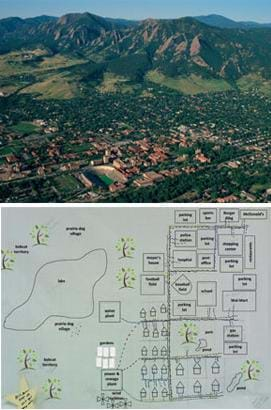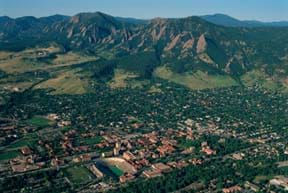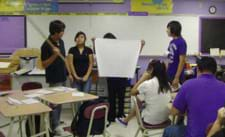
Summary
Students experience civil and environmental engineering by planning a housing development in an existing biome, while also protecting the native species that live there. They conduct research, draw plans, make brochures and give presentations, with each team having a member serving as a project manager, civil engineer, environmental engineer and graphic designer. The best designs creatively balance the needs and resources necessary to support both the native species and human infrastructure.Engineering Connection
Civil and environmental engineers are responsible for drinking and wastewater infrastructure, electricity, road planning and implementation, minimizing environmental impact, and much more when designing and building new housing developments.
Learning Objectives
After this activity, students should be able to:
- Assess the responsibility of human competition with native species.
- Describe adaptations of species specific to certain biomes.
- Recognize resources necessary for the long-term survival of species.
- Demonstrate how environmental conservation may limit impact on ecosystems.
Educational Standards
Each TeachEngineering lesson or activity is correlated to one or more K-12 science,
technology, engineering or math (STEM) educational standards.
All 100,000+ K-12 STEM standards covered in TeachEngineering are collected, maintained and packaged by the Achievement Standards Network (ASN),
a project of D2L (www.achievementstandards.org).
In the ASN, standards are hierarchically structured: first by source; e.g., by state; within source by type; e.g., science or mathematics;
within type by subtype, then by grade, etc.
Each TeachEngineering lesson or activity is correlated to one or more K-12 science, technology, engineering or math (STEM) educational standards.
All 100,000+ K-12 STEM standards covered in TeachEngineering are collected, maintained and packaged by the Achievement Standards Network (ASN), a project of D2L (www.achievementstandards.org).
In the ASN, standards are hierarchically structured: first by source; e.g., by state; within source by type; e.g., science or mathematics; within type by subtype, then by grade, etc.
NGSS: Next Generation Science Standards - Science
| NGSS Performance Expectation | ||
|---|---|---|
|
HS-ESS3-4. Evaluate or refine a technological solution that reduces impacts of human activities on natural systems. (Grades 9 - 12) Do you agree with this alignment? |
||
| Click to view other curriculum aligned to this Performance Expectation | ||
| This activity focuses on the following Three Dimensional Learning aspects of NGSS: | ||
| Science & Engineering Practices | Disciplinary Core Ideas | Crosscutting Concepts |
| Design or refine a solution to a complex real-world problem, based on scientific knowledge, student-generated sources of evidence, prioritized criteria, and tradeoff considerations. Alignment agreement: | Scientists and engineers can make major contributions by developing technologies that produce less pollution and waste and that preclude ecosystem degradation. Alignment agreement: When evaluating solutions it is important to take into account a range of constraints including cost, safety, reliability and aesthetics and to consider social, cultural and environmental impacts.Alignment agreement: | Feedback (negative or positive) can stabilize or destabilize a system. Alignment agreement: Engineers continuously modify these technological systems by applying scientific knowledge and engineering design practices to increase benefits while decreasing costs and risks.Alignment agreement: |
| NGSS Performance Expectation | ||
|---|---|---|
|
HS-LS2-7. Design, evaluate, and refine a solution for reducing the impacts of human activities on the environment and biodiversity. (Grades 9 - 12) Do you agree with this alignment? |
||
| Click to view other curriculum aligned to this Performance Expectation | ||
| This activity focuses on the following Three Dimensional Learning aspects of NGSS: | ||
| Science & Engineering Practices | Disciplinary Core Ideas | Crosscutting Concepts |
| Design, evaluate, and refine a solution to a complex real-world problem, based on scientific knowledge, student-generated sources of evidence, prioritized criteria, and tradeoff considerations. Alignment agreement: | Moreover, anthropogenic changes (induced by human activity) in the environment—including habitat destruction, pollution, introduction of invasive species, overexploitation, and climate change—can disrupt an ecosystem and threaten the survival of some species. Alignment agreement: Biodiversity is increased by the formation of new species (speciation) and decreased by the loss of species (extinction).Alignment agreement: Humans depend on the living world for the resources and other benefits provided by biodiversity. But human activity is also having adverse impacts on biodiversity through overpopulation, overexploitation, habitat destruction, pollution, introduction of invasive species, and climate change. Thus sustaining biodiversity so that ecosystem functioning and productivity are maintained is essential to supporting and enhancing life on Earth. Sustaining biodiversity also aids humanity by preserving landscapes of recreational or inspirational value.Alignment agreement: When evaluating solutions it is important to take into account a range of constraints including cost, safety, reliability and aesthetics and to consider social, cultural and environmental impacts.Alignment agreement: | Much of science deals with constructing explanations of how things change and how they remain stable. Alignment agreement: |
International Technology and Engineering Educators Association - Technology
-
Students will develop an understanding of the role of troubleshooting, research and development, invention and innovation, and experimentation in problem solving.
(Grades
K -
12)
More Details
Do you agree with this alignment?
-
Students will develop an understanding of the attributes of design.
(Grades
K -
12)
More Details
Do you agree with this alignment?
State Standards
Texas - Science
-
analyze and discuss how human activities such as fishing, transportation, dams, and recreation influence aquatic environments; and
(Grades
10 -
12)
More Details
Do you agree with this alignment?
-
evaluate the impact of research and technology on scientific thought, society, and the environment;
(Grades
10 -
12)
More Details
Do you agree with this alignment?
-
evaluate the effect of human activities, including habitat restoration projects, species preservation efforts, nature conservancy groups, hunting, fishing, ecotourism, all terrain vehicles, and small personal watercraft, on the environment;
(Grades
11 -
12)
More Details
Do you agree with this alignment?
Materials List
Each group needs:
- 1 sheet typing paper (have a few extra sheets available in case groups need to start over)
- 1 sheet chart paper (large size, for map making)
- pencils or other coloring utensils
- ruler
- access to a computer with Internet access (for research)
- research journal (notebook of lined paper), one per person
- Student Worksheet, one per person
- Biomes and Species List, one per class
Worksheets and Attachments
Visit [www.teachengineering.org/activities/view/uoh_working_activity1] to print or download.Pre-Req Knowledge
Students should already have an understanding of biomes, including the characteristics of and ability to identify abiotic and biotic factors. Students should also be familiar with species interactions, including competition and interdependence.
Introduction/Motivation
Now that you are in high school, you need to start considering careers for yourselves in order to make wise decisions in your college choices. During today's activity, you will learn about some career options (such as civil and environmental engineering!) while also saving the natural environment. You may discover talents you didn't know you had until now! How do you feel about the environment? If you don't care, then how do you feel about the ability to have indoor plumbing? If you still don't care, how do you feel about creating something that you are proud of? And if none of those made you smile, how do you feel about telling others what to do? You will get the chance to explore each of these aspects in the activity that we are about to do. You will also prove to me how much you have learned about ecosystems and engineering, and make me smile in return!
Let's get started by thinking generally about housing developments. Why do we see new housing developments appear where none existed before? (Listen to student answers; possible answers: population growth, people want newer houses, people want less-expensive houses.) What happens to native species when humans encroach on their habitats? (Listen to student answers; possible answers: species' populations decrease, species die, habitats are altered.) Who works to ensure that environmental impact is considered in a new housing development? (Answers: Civil engineers, environmental engineers, planners.)
Today, you are responsible for designing a new housing development for a certain area. But there's a catch! The local environmental group is in an uproar about your development because of a species native to the area that the environmentalists are concerned about. So, you must practice responsible engineering by reducing the impact of your development on an animal species. Typically, engineers evaluate and design for many possible effects that a development might have on a biome, and think about multiple plant and animal species. Today, you will focus on protecting just one species, and get a taste for civil and environmental engineering while doing it!
Procedure
Before the Activity
- Quiz students about the concepts covered in the Vocabulary/Definitions section, specifically biomes, ecosystems, species, populations, communities, civil and environmental engineering, to ensure that the terms are appropriately applied throughout this project.
- Gather materials and make copies of the Biomes and Species List (one copy for the class), Student Worksheet (one per student).
With the Students
- Have students prepare for the activity by creating research journal entries to initiate the project.
- Elicit student curiosity by asking them: What happens to native species when humans encroach? Write the question on the board. Give students several minutes to reflect on the question and enter responses into their research journals.
- Engage students by introducing the project. Tell them to take notes in their research journals as you explain the overall activity project.
- The class will be divided into groups of four students each.
- Each group will be assigned a biome: a deciduous forest, desert or grassland.
- Each group will be assigned a species native to its biome.
- Each group member will be assigned a role: project manager, civil engineer, environmental engineer or graphic designer.
- Each group will be responsible for designing a housing development of 50 houses located in its biome that takes into account the needs of its native species. Local environmentalists are incredibly upset that people are planning to place a housing development where this native species lives, and the group must consider the needs of the species in its planning.
- Students will conduct research on their species and methods they can incorporate into their planning to reduce environmental impact caused by a housing development.
- Each group is ultimately expected to create three products: a pamphlet advertising its housing development plans to buyers, a map showing the proposed housing and city services, and a presentation during which the group "sells" its housing development plans to the class (who acts as the buyer).

- Divide the class into groups of four students each and assign each different biome: deciduous forest, desert or grassland. If you have more than three groups in your class, assign multiple groups to each biome.
- Remind students that they are to plan their housing developments for implementation in their specific biomes, and will be assigned one species to protect that is native to that biome. For example, one group might work to protect bees in their grassland housing development plans, while another group focuses on designing a development in grasslands that protects armadillos, etc. Then assign (or permit students to pick) the species to protect from the Biomes and Species List.
- Give students research time to explore strategies that engineers and developers use to minimize environmental impacts when planning for a new housing development. If students are confused about what types of problems housing developments can cause on species and the environments, get them thinking about humans introducing noise pollution to a nesting ground, or bulldozing a road through an area where animals hunt, or polluting water with toxic landscaping chemical runoff, or filling marshlands with soil! Countless examples exist for how humans impact environments when we plan and build new developments; talk to students about some of these examples to get them on the right track. Give students 20 minutes to conduct Internet research in the computer lab. Remind them to take notes on their findings in their research journals. TIP: If students get stuck, suggest they perform searches on "green housing developments" and "green neighborhood design."
- Lead a class discussion in which a representative from each group is called on to explain to the class what his/her team has learned about strategies that engineers and developers use to minimize the environmental impact of housing developments. Below are possible techniques and talking points to guide the discussion:
- Green-building techniques used for homes (solar panels for solar hot water and electricity, programmable thermostats, Energy Star certification, high-efficiency fireplaces that function as primary heat sources, ultra low-flow faucets and showerheads)
- Native species landscaping and shading
- Gray water reused for low-water, native landscaping
- Placing houses closer together to minimize individual yard space, while maximizing shared/common spaces and open/green spaces
- Planted roofs to reduce rainwater runoff and prevent erosion
- Rainwater catchment systems
- Mass transit/public transit/shared car systems to keep people off the roads and ensure that the streets are as narrow as possible
- Habitat restoration and conservation plans
- Multi-family buildings to minimize housing footprints through compactness
- Porous asphalt street systems for managing rainwater and preventing runoff
- Tree planting and preservation of mature trees, which are crucial bird habitats
- Community gardens and orchards
- Assign each group member one of four possible roles: civil engineer, environmental engineer, graphic designer or project manager. Give students five more minutes to research what his/her assigned professional does for work.
- Instruct students to record their findings on the first page of their worksheets.
- Explain to students how they will function in their roles during the rest of the activity:
- Project manager: Serves as editor of the wording on the pamphlet, checks in with other group members to make sure they are accomplishing their tasks.
- Civil engineer: Considers city services and maps the development layout, including placement of roads, sewers, sidewalks, parks, open space, etc.
- Environmental engineer: Becomes an expert about the groups' assigned biome and native species to protect. The environmental engineer approves the civil engineer's designs and provides pamphlet information.
- Graphic designer: Sketches the development design on chart paper and the pamphlet cover design.
- Give students 20 more minutes to conduct Internet research pertaining to their responsibilities. The project manager helps the civil engineer research how housing developments are planned and layouts are decided upon. The graphic designer helps the environmental engineer research the groups' assigned biome and native species to protect.
- Instruct students to fill out the second page of the worksheets.
- Give students time to brainstorm at least three possible alternative housing development plans (remember, for 50 houses) for their biome that minimize impact to their assigned species. Remind them to record their ideas in their research journals. Give students time to sketch their initial plans on the paper, and time for evaluation and analysis of the options. Encourage students to really discuss and dissect the trade-offs of development features versus conservation success for each design. Instruct students to choose one final plan, and defend the choice they made with explanations documented in their research journals. Mention to students that engineering teams often use the process of first brainstorming many wild ideas, followed by evaluation of the pros and cons of the ideas, and then selection of the best idea (or combination of ideas) for a given situation.

- Have students elaborate on their findings by creating pamphlets about their developments, as well as larger-scale, finalized maps that show strategies in environmental conservation (see Example Student-Designed Development Plan). Suggest that students create tri-fold brochures, with the front displaying the development name and logo created by the graphic designer. Inside, have the left panel describe the amenities that the development offers, the middle panel explain their environmental engineering conservation efforts in regard to the protected native species (displaying knowledge of the adaptations and resources required for said organism), and the right panel provide information about the biome. Have them place on the panel that folds inward the group member names, roles and job duty descriptions.

- Have each group make a presentation of its findings and proposed neighborhood development plans to the rest of the class (who serve as the client). See the attached Grading Rubric for ideas on how to grade the final products. Students who are not presenting evaluate the presentations on their creativity and success in conserving resources for native species and providing amenities in the development. Have students record their thoughts in their research journals. Make things more fun by creating awards, such as "most creative," and "most organized." After all groups have presented, have students vote for the "people's choice" award—the development they think is best. Announce the winner, and discuss as a class why that development won. Focus the discussion on the developers' success in balancing the conservation of resources for native species with the need to provide amenities for people.
- After watching all presentations and receiving feedback from classmates on their designs, have students talk with their teams for five minutes, and come up with at least two ways that they could improve upon their development designs. Mention to students that engineering teams make it a point to learn from customer feedback and the testing results of their best designs, leading them to re-design and make improvements. Have them describe their ideas in their research journals.
Vocabulary/Definitions
abiotic: An abiotic factor is a physical, or nonliving, factor that shapes an ecosystem.
biome: A group of ecosystems that have the same climate and dominant communities.
biotic: A biotic factor is a biological influence on organisms within an ecosystem.
civil engineering: A type of engineering concerned with the design, construction and maintenance of various municipal infrastructures, such as streets, bridges, highways, water treatment, water supply distribution networks, sewers, solid waste, etc.
community: An assemblage of different populations that live together in a defined area.An assemblage of different populations that live together in a defined area.
deciduous forest: An area containing trees or shrubs that lose their leaves seasonally, flowering plants that lose their petals post-flowering, and plants that shed fruit when ripe.
desert: An area that receives very low amounts of precipitation, making it unable to support most plants.
ecosystem: A community of living things and the environment in which they live. For example, a prairie ecosystem includes coyotes, the rabbits on which they feed, the grasses that feed the rabbits, and a climate that supports the grasses. An ecosystem is a system of interacting and interdependent relationships.
environmental engineering: A type of engineering that emphasizes restoring, maintaining or improving the environment, specifically air, water and/or land resources.
graphic designer: A professional artist that designs images used in all types of media, promotion and advertising.
grassland: An area in which vegetation is dominated by grasses and other non-woody plants.
niche: A full range of physical and biological conditions in which an organism lives and the way in which the organism uses those conditions.
population: A group of individuals of the same species that live in the same area.
project manager: A lead engineer who manages a given project and oversees project planning, organizing, delegation and client relations.
species: A group of similar organisms that can breed and produce fertile offspring.
Assessment
Pre-Activity Assessment
Concept Review: Quiz students about the concepts covered in the Vocabulary/Definitions section, specifically biomes, ecosystems, species, populations, communities, civil and environmental engineering, to ensure that the terms are appropriately applied throughout this project.
Activity Embedded Assessment
Worksheet: Have students use the Student Worksheet at various points in the project. Review their answers to gauge their mastery of the subject.
Communication: After research, brainstorming, evaluation and selection of the best plan to protect a species in a given biome, student teams synthesize their knowledge into pamphlet, poster/map and presentation form to communicate it to others. Use the Grading Rubric to assess the depth of their concept and project understanding.
Post-Activity Assessment
Research Journals: Collect and grade student research journals to assess individual mastery of the targeted standards.
Activity Extensions
Have students extend their learning by considering real-world projects, such as actual community developments being proposed and considered, as well as future mega-stores (for example, Wal-Mart has received approval to build in the Heights of Houston, considered a historic and small business ownership-oriented region of Houston). Have students write letters to developer offering solutions to lessen the impact to the community or species of interest.
Activity Scaling
- For lower grades, permit some errors in municipality planning (such as bad sewer or water lines, etc.) in the grading rubric.
- For upper grades, require that students create higher-quality pamphlets (on a computer, using graphic design software applications) as well as more technically accurate maps, drawn to scale.
Subscribe
Get the inside scoop on all things TeachEngineering such as new site features, curriculum updates, video releases, and more by signing up for our newsletter!More Curriculum Like This

As students learn about the creation of biodomes, they are introduced to the steps of the engineering design process, including guidelines for brainstorming. They learn how engineers are involved in the design and construction of biodomes and use brainstorming to come up with ideas for possible biod...

Students are introduced to innovative stormwater management strategies that are being used to restore the hydrology and water quality of urbanized areas to pre-development conditions. A PowerPoint® presentation provides photographic examples, and a companion file gives students the opportunity to sk...
References
Miller, Kenneth R. and Joseph Levine, Biology, Needham, MA: Pearson-Prentice Hall, 2004.
Other Related Information
Note: This curriculum employs the AVID strategy [www.avid.org], a nationwide elective for college readiness, which, in this activity employs student research journals and the following sequence: elicit, engage, explore, explain, elaborate, evaluate and extend.
Copyright
© 2013 by Regents of the University of Colorado; original © 2009 University of HoustonContributors
Myla Van Duyn, (Davis High School, Houston ISD); Marissa H. ForbesSupporting Program
National Science Foundation GK-12 and Research Experience for Teachers (RET) Programs, University of HoustonAcknowledgements
Created through the University of Houston's Cullen College of Engineering's NSF Research Experience for Teachers (RET) Program, grant no. 1130006. However, these contents do not necessarily represent the policies of the National Science Foundation and you should not assume endorsement by the federal government.
Last modified: May 11, 2021









User Comments & Tips